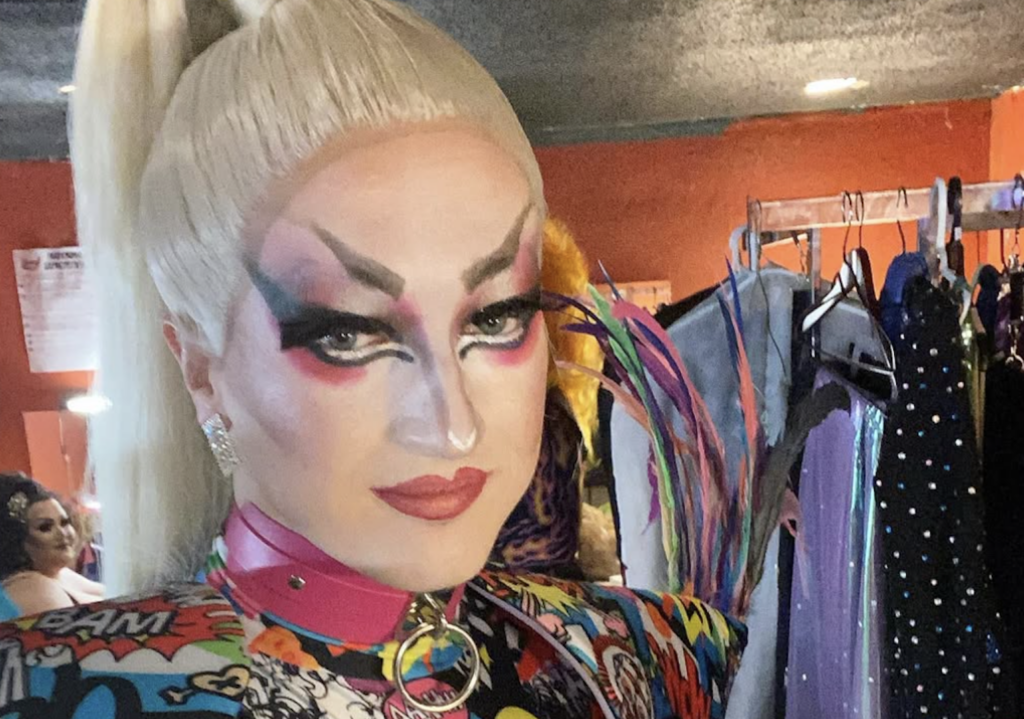Charlotte Street’s Stench of Rotting Flowers: brilliantly decadent decay


It started with a ghost. Charlotte Street curator-in-residence Danny Orendorff divined the subject for his latest exhibition, The Stench of Rotting Flowers, from a haunting photograph of a now-deceased glamour-puss. The photograph in question, Peter Hujar’s haunting “Candy Darling on Her Deathbed,” captures one of Andy Warhol’s superstars posing in her hospital bed, facing death with flowers and flawless lipstick.
“I wanted to explore the tonal affectations of bereavement,” Orendorff explains. “Our attachment to heartbreak and sorrow and how we can become indulgent in it all.”
That theme, decadence in the face of decay, echoes throughout the exhibition, though Hujar’s photo isn’t part of it. The 13 artists on display at La Esquina collate diverse, secular responses to grief, often fusing ceremonial qualities with camp appeal.
It’s nothing new for Orendorff, whose curatorial residency has been marked by an interrogative engagement with social and political themes. No matter the subject, Orendorff’s selections probe barriers: between classes, between cultures, between fine art and mass-produced kitsch.
The latter division is on full display in local artist Rain Harris’ porcelain confections. Orendorff selected two pieces from her “Poison Bottle” series for the show at La Esquina, and they look, at first blush, like something you might find on your grandmother’s dressing table. The organic shapes bloom with feminine curves and ornate embellishments, floral patterns lustered to a pearlescent sheen. But Harris amps up the accents to a garish pitch, adorning her pieces with plenty of low-culture flairs. Barbie hair spills from the spouts of “Bon Bons for Babs,” cheap rhinestones trapping light around its base. “Festoon” adds feathers to the mix, as well as an erotic charge in the form of pointy, gold-dipped nubs that jut from the bottle like nipples. Harris’ “Poison Bottle” pieces are glamour made grotesque, a worthy complement to Candy Darling’s toilette.
They’re also incredibly detailed and fastidious, another important connection to the economy of loss. “I wanted to draw out qualities of the handmade, the meticulously made,” Orendorff says. Those touches tap into the labor and cost of planning a funeral.
It’s hard to imagine something more enormous than Jesse Harrod’s sculpture, a lavender tissue box nearly 10 feet tall. “The Enormity of Lesbian Grief” is a behemoth of taffeta and lace from discarded wedding dresses, part minimalist sculpture, part radical nod to the Lavender Menace, a group of lesbian protestors in the 1970s. “Enormity” evokes a tension between the domestic connotations of wedding dresses and handcraft and the sculpture’s more threatening scale and sexual imagery. Lace details droop from the flowers’ openings like probing, wet tongues.
Many of the works at La Esquina are similarly grand in scale, including an unusually large painting by Peregrine Honig. The local artist’s “#DiscoSaintSelfie” anchors the exhibit in an intricate combination of insincere self-indulgence and authentic beauty. The materials are just as diverse: A lush floral wreath, rendered in oils, is complicated by a fractured halo of mirror-ball tiles (poised at head height — perfect for snapping selfies). Glue drips across the tiles, coating the surface in an unctuous film. On the floor, Easter lilies peek from peat moss, flanking the painting and inviting you to approach as if to an altar. The flowers were lush and blooming on this show’s opening day, but you can imagine the lilies withering and curling with time, diffusing the fouler perfume that Orendorff’s title suggests.
It may seem hard to reconcile Edie Fake’s dazzling pen-and-ink meditations with hashtags and Barbie hair, but Orendorff is determined to give authentic grief its due. Fake’s “Gateway” drawings are individual imaginings for deceased friends, blueprints for an afterlife custom-built for one. The vibrant, saturated colors and tessellated shapes evoke Islamic tile work or Navajo textiles, sacred explorations of geometric designs. Fake’s work is characterized by meticulous mark making: Each exacting pen line seems like a meditation, a secular analogue to worrying rosary beads between your fingers.
Though tonally different from some of the other works on display, Fake’s elaborate portals offer a reminder well within the show’s context: Pain questioned or mocked is not pain less keenly felt. No matter how the artists might denigrate the saccharine, loss and grief remain enormous, complex specters. The Stench of Rotting Flowers succeeds in teasing out diverse, at times contradictory, responses to grief, capturing the solemn as well as the silly. Candy Darling had it right: Loss can be luxurious, a floral perfume turning sickly in the air.




